Fraction On a Number Line: Introduction
A fraction number line, as the name suggests, represents fractions on a number line. Fractions represent the parts of a whole or collection. A fraction has two parts: numerator and denominator. The numerator represents the number of equal parts taken and is written at the top. Denominator represents the total number of equal parts in a whole and is written at the bottom.
For example: In the fraction $\frac{3}{4}, 3$ is the numerator and 4 is the denominator. Also, it represents that 3 parts are taken out of 4 equal parts.
Recommended Games
What Is a Number Line?
In math, a number line is defined as a straight line with numbers placed at equal intervals or segments along its length. A number line can be extended infinitely in any direction and is usually represented horizontally.
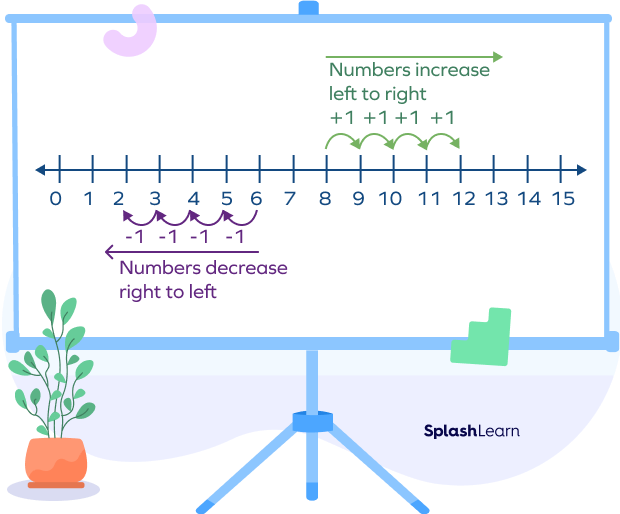
The numbers on the number line increase as we move from left to right and decrease on moving from right to left.
Recommended Worksheets
What Is a Fraction on Number Line?
A fraction number line is simply a number line with fractions represented on it. It is a horizontal number line that displays two whole numbers at either end of the line. We can identify and plot all the fractions lying between these two whole numbers.
Consider a number line. Let’s divide the sections between the whole numbers 0 and 1, 1 and 2 and so on into 2 equal parts. Each part will represent the fraction $\frac{1}{2}$.
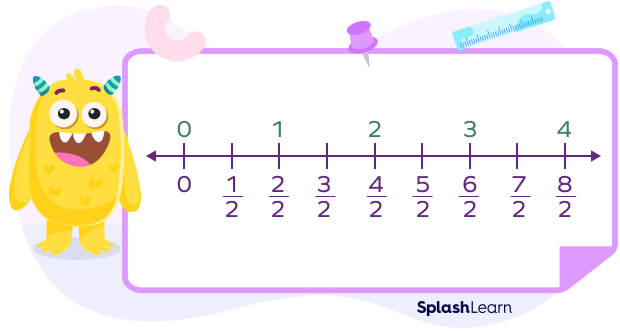
Starting from 0 if we keep adding $\frac{1}{2}$, we will get
$\frac{1}{2}$
$\frac{1}{2} + \frac{1}{2} = \frac{2}{2} = 1$
$\frac{2}{2} + \frac{1}{2} = \frac{3}{2}$
$\frac{3}{2} + \frac{1}{2} = \frac{4}{2} = 2$
This way the fraction number line can also be used to represent whole numbers as fractions.
Take a look at the fraction number line chart!
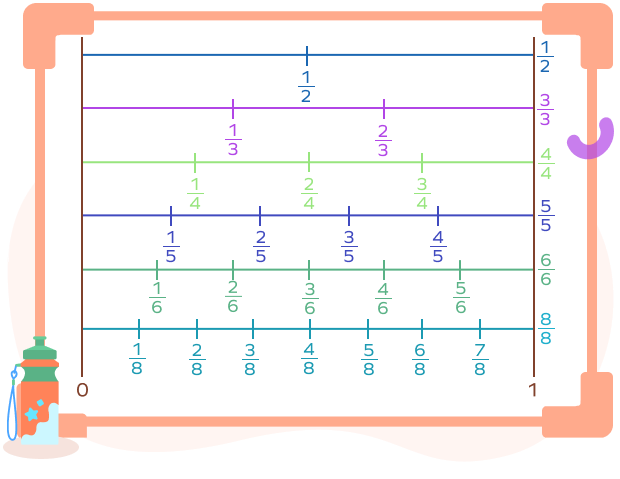
How to Represent Fractions on a Number Line
Let’s understand how to represent different types of fractions on a number line.
Proper Fractions on a Number Line
Proper fraction is a fraction whose denominator is greater than the numerator, such as $\frac{1}{4},\frac{2}{9},\frac{27}{35}$, etc. They lie between 0 and 1. To represent a proper fraction on a number line, we divide the segment joining 0 and 1 into the number of equal parts equal to the denominator of the fraction. The marking equal to the numerator represents the given fraction.
Suppose we have to mark $\frac{5}{6}$ on the number line.
Step 1: Draw a horizontal fraction number line of a suitable length.
Step 2: Since $\frac{5}{6}$ is a proper fraction, it lies between 0 and 1. Mark 0 and 1 on the number line.
Step 3: Divide the line segment between 0 and 1 into 6 equal parts since the denominator of the fraction is 6.
Step 4: Count 5 parts from the left since the numerator of $\frac{5}{6}$ is 5. Name the marking as $\frac{5}{6}$.
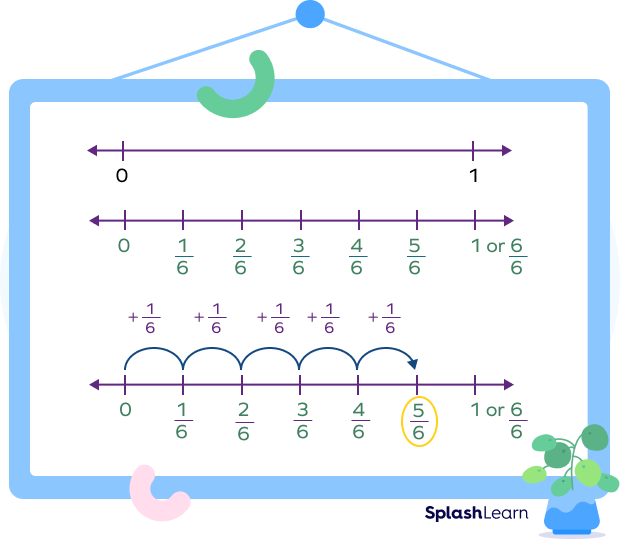
Consider another example. $\frac{2}{3}$ is a proper fraction. Thus, it lies between 0 and 1. To represent $\frac{2}{3}$ on a number line, we first divide the segment joining 0 and 1 into 3 equal parts. The second marking represents the fraction $\frac{2}{3}$.
Equivalent Fractions on a Number Line
Equivalent fractions are fractions that have different numerators and denominators, but they still represent the same value. Thus, equivalent fractions take the same place on the number line.
For example: Let us mark $\frac{1}{2}$ and $\frac{2}{4}$.
To represent $\frac{1}{2}$, we divide 0 and 1 into 2 parts and choose the second marking.
To represent $\frac{2}{4}$, we divide 0 and 1 in 4 parts and choose the second marking.
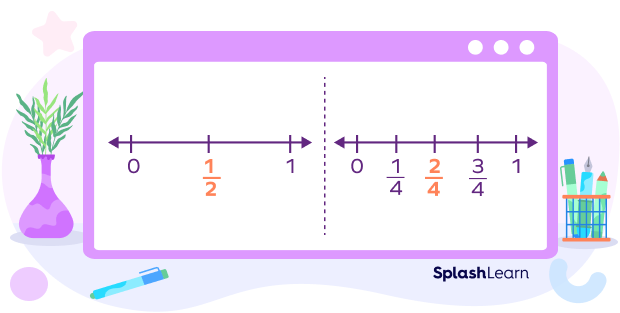
Mixed Fractions on a Number Line
A mixed number is a whole number and a proper fraction represented together, such as $1\frac{2}{3},2\frac{2}{5},12\frac{1}{8}$, etc. It generally represents a number between any two whole numbers. Note that the mixed numbers or the mixed fractions are always greater than 1 since its numerator is greater than the denominator.
Let’s understand how to represent a mixed fraction on a number line. Suppose, we have to mark $3\frac{3}{4}$ on the number line.
Step 1: First, find the whole number part of the mixed number. In this example, the whole number part is 3. So, the mixed fraction lies between 3 and 4.
Step 2: The fractional part is $\frac{3}{4}$. Thus, divide the above line segment into four equal parts. Each part represents $\frac{1}{4}$.
Step 3: Go to the fractional part. In this example, go to $\frac{3}{4}$.
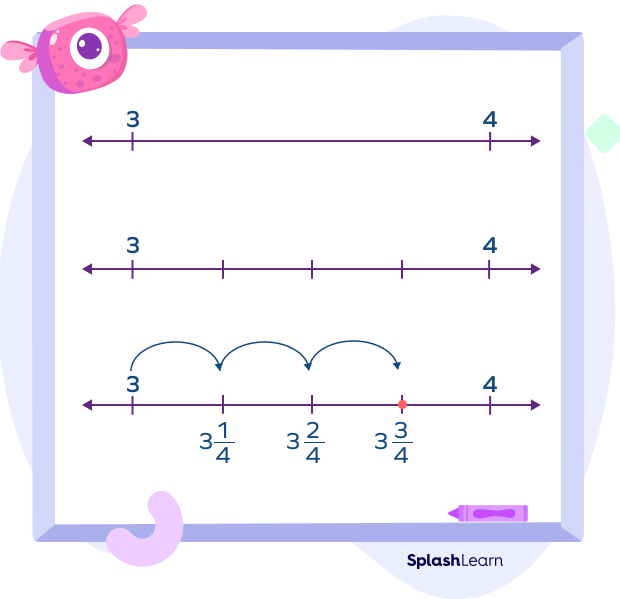
Improper Fractions on a Number Line
Improper fractions are the fractions in which the numerator is greater than the denominator. Examples: $\frac{7}{5},\frac{19}{6},\frac{101}{45}$, etc. They are always greater than 1. To represent an improper fraction on a number line, we can always convert it to a mixed fraction, but, here we will discuss another method.
Suppose, we have to plot $\frac{5}{2}$ on the number line.
Step 1: First, look at the denominator. The denominator is 2. So, split each whole into 2 equal parts starting from 0.
Step 2: Then, look at the numerator. The numerator is 5. So, start at 0 and count forward 5 parts. The result is $\frac{5}{2}$.
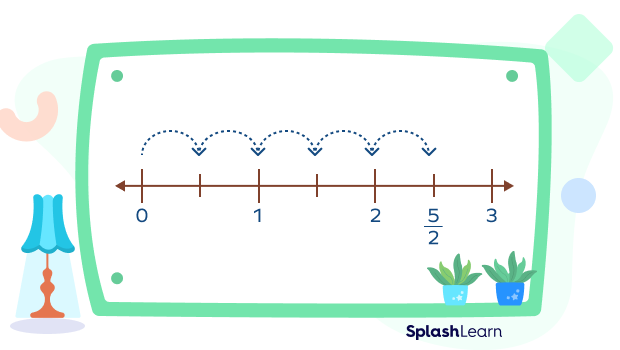
Conclusion
In this article, we learned about the fraction number line. The fraction number line is used to represent fractions.
Solved Examples on Fraction on a Number Line
1. Represent the given fraction on a number line: $\frac{7}{10}$
Solution:
710 is a proper fraction as the numerator is less than the denominator. So, it will lie between 0 and 1. Dividing 0 and 1 into ten equal parts, we get:

A represents $\frac{7}{10}$.
2. Represent the given mixed fraction on a fraction number line: $2\frac{3}{5}$
Solution:
$2\frac{3}{5}$ is a mixed fraction and lies between 2 and 3. Divide the section joining 2 and 3 into 5 equal parts. The third marking represents the mixed fraction $2\frac{3}{5}$.
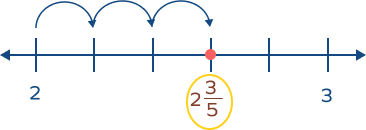
3. Represent the given improper fraction on a number line: $\frac{13}{8}$
Solution:
Improper fractions are greater than 1. Split each whole part into 8 equal parts. The 13th part starting from 0 represents $\frac{13}{8}$.

4. Represent the given fraction on a number line: $\frac{5}{7}$
Solution:
Divide 0 to 1 section into 7 equal parts. The fifth part represents $\frac{5}{7}$.

Practice Problems on Fraction on a Number Line
Fraction On Number Line - Definition With Examples
What is the value of A on the fraction number line?

Each whole is divided into 4 parts and each part represents $4\frac{1}{4}$. So, A represents the mixed fraction $1\frac{1}{4}$.
Thus, $1\frac{1}{4} = \frac{4 + 1}{4} = \frac{5}{4}$
On the fraction number line, $\frac{17}{5}$ will lie between which two whole numbers?
On converting $\frac{17}{5}$ to mixed fraction, we get $3\frac{2}{5}$. It will lie between 3 and 4.
A number line is given with 4 missing values denoted by points P, Q, R, and S. Find the missing values by using your understanding of fractions on a number line.

Let’s label each fraction on a number line.

Frequently Asked Questions on Fraction on a Number Line
How to order fractions on the fraction number line?
The fractions that lie on the right side are greater than the fractions that are on their left side. For ordering the fractions on a number line, the fraction written on the leftmost side is the smallest and the fraction written on the rightmost side is the largest fraction, and all the other fractions between these two fractions can be compared based on their positions.
How to add like fractions using the number line?
For adding and subtraction the like fractions using the number line, we will first plot the first fraction on the number line and move the number equal to the numerator of the other fraction to the right of the first fraction.
What do the numerator and denominator of the fraction represent?
The denominator of a fraction represents the number of equal parts in which the whole is divided. The numerator of a fraction represents the number of parts which are chosen.




































